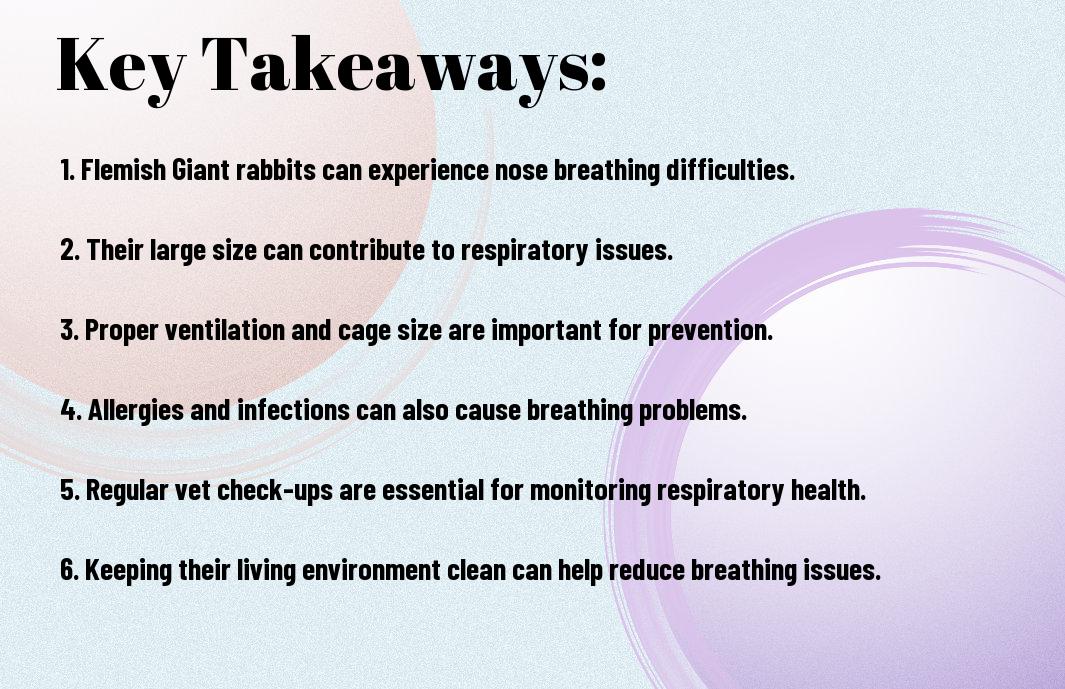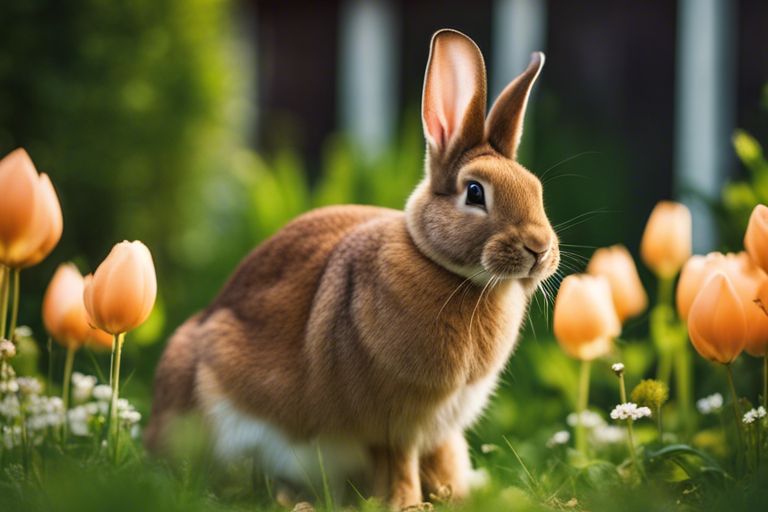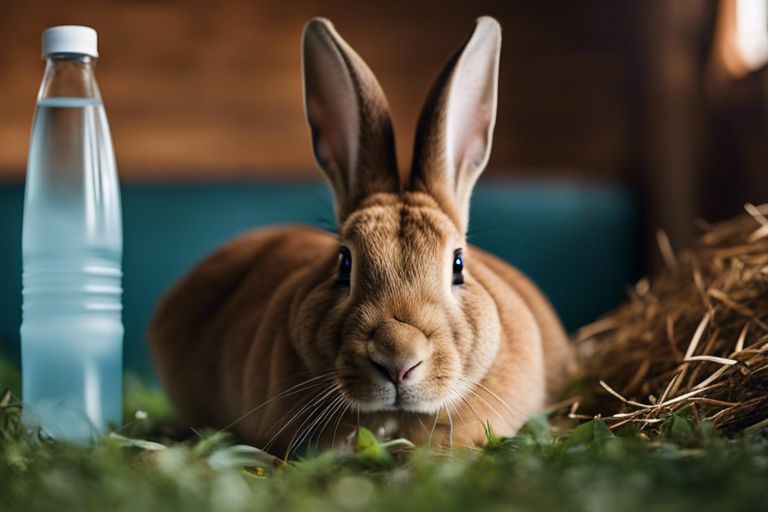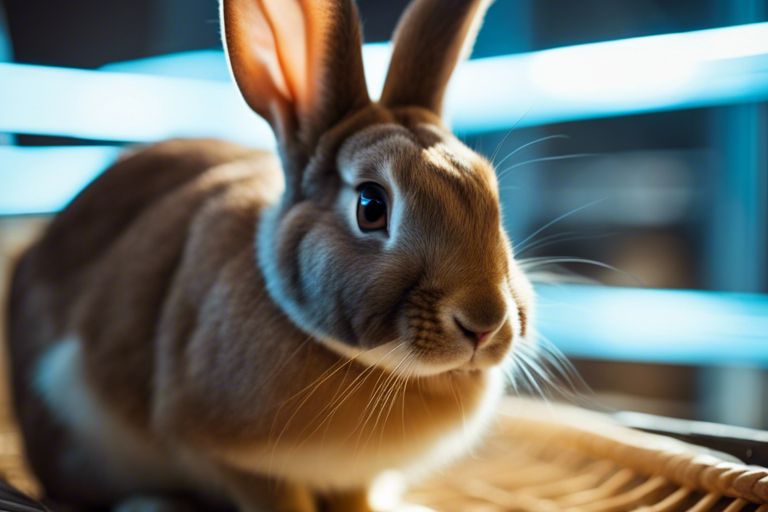As a pet owner, you may not be aware that Flemish Giant rabbits are prone to nose breathing difficulties due to their unique facial structure. This can result in respiratory issues that may require medical attention to manage effectively. However, with proper care and regular monitoring, you can ensure that your beloved Flemish Giant remains healthy and happy. In this blog post, we will explore the potential causes of nose breathing difficulties in Flemish Giant rabbits and provide you with essential tips for prevention and treatment.
Key Takeaways:
- Flemish Giant rabbits are prone to breathing difficulties due to their unique physiology.
- These breathing difficulties can be exacerbated by environmental factors such as poor ventilation and dusty bedding.
- It is important for owners of Flemish Giant rabbits to monitor their breathing and seek veterinary care if any concerns arise.
- Preventive measures such as providing a clean living environment and regular check-ups can help minimize the risk of respiratory issues.
- Professional advice from a knowledgeable veterinarian can help to mitigate potential breathing problems in Flemish Giant rabbits.

Anatomy of Flemish Giant Rabbits
Any rabbit owner knows that understanding the anatomy of your pet is crucial for recognizing potential health issues and providing the best care possible. Flemish Giant rabbits are no exception, and their anatomy plays a significant role in their respiratory health.
Nasal Structure
The nasal structure of Flemish Giant rabbits is quite intricate, with large nostrils and a well-developed nasal cavity. This allows for efficient airflow and the ability to detect a wide range of scents. However, their long ears and facial structure can also make them more prone to respiratory issues if not cared for properly.
Comparative Respiratory Systems
When comparing the respiratory systems of Flemish Giant rabbits to other breeds, there are several key differences to note. While they have a similar basic respiratory system to other rabbits, their larger size means they require more efficient oxygen exchange and are more susceptible to heat stress. Additionally, their elongated head and face can make them more prone to nasal breathing difficulties if there are any obstructions.
| Most Important Details | Dangerous Details |
| Larger size requires more efficient oxygen exchange | More prone to heat stress |
| Elongated head and face can lead to nasal breathing difficulties |
Understanding the unique nasal structure and comparative respiratory systems of Flemish Giant rabbits is essential for providing optimal care for your furry friend.

Breathing Issues in Flemish Giant Rabbits
Your Flemish Giant rabbit may be prone to certain breathing issues due to their large size and specific breed characteristics. It’s important to be aware of these potential problems so that you can provide the best care for your pet. For more detailed information on rabbit care and health, you can refer to the Disorders and Diseases of Rabbits – All Other Pets section of the Merck Veterinary Manual.
Common Respiratory Disorders
Some of the common respiratory disorders that Flemish Giant rabbits may face include pneumonia, upper respiratory infections, and snuffles. These conditions can cause difficulty in breathing and may require prompt veterinary attention to prevent further complications. It’s important to monitor your rabbit for any signs of respiratory distress and seek professional help if you notice any abnormal symptoms.
Factors Contributing to Nose Breathing Difficulties
There are several factors that can contribute to nose breathing difficulties in Flemish Giant rabbits. These may include obesity, dental problems, environmental irritants, and genetic predisposition. Any of these factors can lead to an increased risk of respiratory issues in your rabbit, so it’s crucial to keep an eye on your pet’s overall health and environment to minimize these risks.
Diagnosing and Treating Breathing Difficulties
Now that you are aware of the potential nose breathing difficulties that Flemish Giant rabbits can face, it’s important to know how to diagnose and treat these issues. When your rabbit shows signs of respiratory distress, it’s crucial to seek veterinary care immediately. Your vet will conduct a thorough examination, which may include listening to your rabbit’s breathing and taking X-rays to assess the extent of the problem. They may also perform blood tests to check for any underlying infections or health conditions that could be contributing to the breathing difficulties.
Symptoms of Respiratory Distress
If you suspect that your Flemish Giant rabbit is experiencing breathing difficulties, there are several common symptoms to look out for. These may include labored breathing, wheezing, sneezing, coughing, and nasal discharge. Additionally, you may notice that your rabbit is less energetic and spending more time in a hunched position as they struggle to breathe comfortably. It’s important to pay close attention to these signs and seek prompt veterinary care if you observe any of these symptoms.
Available Treatments and Interventions
When it comes to treating breathing difficulties in Flemish Giant rabbits, your vet may prescribe antibiotics if an underlying infection is present. They may also recommend humidifying the air in your rabbit’s environment to help ease their breathing. In more severe cases, oxygen therapy may be necessary to support your rabbit’s respiratory function. Your vet will work with you to develop a treatment plan tailored to your rabbit’s specific needs, which may also include regular check-ups and monitoring to ensure that their breathing difficulties are being effectively managed.

Prevention and Care
Despite the potential for respiratory issues in Flemish Giant rabbits, there are several measures you can take to prevent and care for these problems. By following best practices for respiratory health and creating an optimal diet and environment, you can help minimize the risk of nose breathing difficulties in your beloved pet.
Best Practices for Respiratory Health
Ensuring proper ventilation in your rabbit’s living space is crucial for their respiratory health. Keep their living area clean and well-aerated to reduce the risk of respiratory irritants. Regularly clean and change the bedding to prevent the accumulation of dust and other particles. Additionally, avoid using strong-smelling cleaning products or aerosols near your rabbit, as these can irritate their sensitive respiratory system.
The Role of Diet and Environment
Your rabbit’s diet plays a significant role in their overall health, including their respiratory well-being. Provide a high-fiber, hay-based diet to promote healthy digestion and minimize the risk of respiratory issues. Additionally, ensure they have access to fresh, clean water at all times. Environmental factors, such as excessive heat or cold, can also impact your rabbit’s respiratory health. Maintain a comfortable temperature and keep your rabbit’s living area free of drafts.
Conclusion
Hence, it is important to be aware of the potential breathing difficulties that Flemish Giant rabbits may face due to their unique physiology. Regular check-ups with a veterinarian and monitoring for symptoms such as wheezing, labored breathing, or nasal discharge can help in early detection and management of any respiratory issues. Ensuring a clean and dust-free environment, as well as providing proper ventilation, can also contribute to maintaining the respiratory health of your Flemish Giant rabbit. Overall, being proactive and attentive to your rabbit’s respiratory health is essential in providing them with a comfortable and healthy living environment.
FAQ
Q: Do Flemish Giant Rabbits often face nose breathing difficulties?
A: While Flemish Giant Rabbits can be prone to nose breathing difficulties due to their large size, it is not a common occurrence. However, certain factors such as obesity, dental issues, or respiratory infections can potentially lead to breathing difficulties in these rabbits.
Q: What are the signs of nose breathing difficulties in Flemish Giant Rabbits?
A: Signs of nose breathing difficulties in Flemish Giant Rabbits may include labored or noisy breathing, reluctance to move or exercise, loss of appetite, discharge from the nose, and overall lethargy. It is important to seek veterinary attention if you notice any of these symptoms.
Q: How can I help prevent nose breathing difficulties in my Flemish Giant Rabbit?
A: To help prevent nose breathing difficulties in Flemish Giant Rabbits, it is important to provide a spacious and clean living environment, monitor their weight and diet to prevent obesity, and ensure regular veterinary check-ups. Additionally, providing chew toys and a balanced diet can help maintain proper dental health, which can in turn contribute to overall respiratory health.
